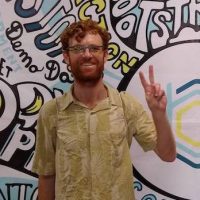I believe bio-sovereignty is critical to a truly free society.
The physical inputs that enter our living system shape our experience of reality. Our consciousness is affected by everything our bodies take in. In order to achieve true sovereignty, we must strive to exert control over what enters into our bodies.
Sovereignty describes the ability to govern an aspect of one’s own reality — or self-governance. It is synonymous with autonomy, independence, and freedom. Political sovereignty signifies control of or access to the power structures that govern our societies.
Bio-sovereignty thus signifies the freedom to self-govern one’s own body, and most importantly the power to make decisions about what passes or does not pass through the boundaries of our physical being.
In the complex world of opaque global supply chains spanning thousands of kilometers, and emerging technologies such as genetic engineering and nanotechnology, the question of what enters our bodies is increasingly difficult to answer — or measure.
Violations of bio-sovereignty include unintended “externalities,” such as air pollution from China affecting air quality in the United States. Other violations are much more intentional, including numerous pharmaceutical trials by large companies in Africa without consent. Governments are at fault as well. A particularly egregious example is the United States Central Intelligence Agency’s top secret MK-Ultra program, a mind-control research effort that included secretly drugging unwitting American citizens with powerful mind-altering substances such as LSD, and then observing their behavior.
To understand the many dimensions of bio-sovereignty, it is instructive to examine some of the most fundamental inputs that sustain life: air, water, and food.
Air may be the most difficult to address, as it is a public good that does not recognize borders, national or biological. Air suffers from the tragedy of the commons, and specifically the global commons. When a corporation faces increasing regulation, they can simply move a factory or production facility to a jurisdiction without such constraints. In what has been coined a “race to the bottom,” jurisdictions compete to deregulate environmental laws treating air and water pollution in order to attract jobs and tax revenue. While grassroots action can affect local air quality, often it only relocates the problem to another locality.
When addressing bio-sovereignty with respect to air, natural questions emerge about power structures: Who has the right to pollute? From where have those groups derived such a right? Often, centralized governments collude with multinational corporations to violate the environmental rights of local populations, whether it be by changing laws or simply ignoring them.
Water shares similar qualities to air, in that it can be viewed as a public good that suffers from the “tragedy of the commons,” does not observe national boundaries, and is therefore difficult to regulate. Water carries invisible but harmful traces of contaminants such as agricultural pesticides, pharmaceutical medicines, microfibers, hydrocarbons, and byproducts from industrial and mining processes. The interconnected nature of water is a case study for the interconnection of all life within the biosphere, and a lesson of why it is both difficult and dangerous to compartmentalize pieces of an interdependent whole.
I propose to approach the question of water in two dimensions: control of contaminants, and control of the water itself.
Rising levels of ingestion of powerful pharmaceutical medicine by the populace leads to the entry of pharmaceutical traces into the water supply. These water-borne traces eventually flow into agricultural land and rivers, and in turn we can ingest them through the food we consume. The EPA (Environmental Protection Agency) is becoming increasingly aware of this threat. Similarly, microfibers from synthetic fabrics in our clothing are entering the water supply. In an economy where planned obsolescence (the practice of planning or designing a product with an artificially limited useful life)is common practice, the material throughput of such fabrics through the supply chain is accelerating. The introduction of nanoparticles into fabrics further exacerbates these detrimental effects. Nanotechnology is progressively being introduced to consumer products, without any clear disposal strategy.
Moving to the question of the control of the water supply, I propose that we consider water the “petroleum,” or key global resource, of the twenty-first century. Consider the case study of Bolivia. The government of Bolivia accepted a $2.5 billion contract to hand over a municipal water system to a multinational corporation, which then attempted to prohibit citizens from harvesting and collecting rainwater from the sky, leading to severe civil unrest. Sustained protest by organized groups of farmers followed, ultimately causing dissolution of the former government, a transfer of power to a farmer-led coalition, and a rescission of the water laws. Like other parts of the world, Latin America has seen a number of violations of the water rights of local communities. To name only one example, Coca-Cola has been shown to exploit the water resources of indigenous communities in Mexico.
Faced with the might of state and corporate power, what solutions can we apply to water sovereignty?
In all cases, a shrinking of the supply chain applies. To control inputs into the supply chain, the logical solution is to control the supply chain itself. How to achieve water autonomy? Rainwater collection is a natural first step. Beyond that, harvesting water via wells, natural springs, or other sources in one’s immediate local vicinity dramatically shortens the supply chain and increases control and autonomy. Innovative solutions such as the Warka Water tower are empowering African villages to source their own water, rather than utilizing hard-earned cash to purchase clean water from private corporations. Applying permaculture design principles such as creating swales on contour to construct a water retention landscape are an extremely effective tool to achieve water sovereignty and self-sufficiency. NuMundo impact center and environmental research center Tamera is a shining case study. Tamera has been recognized globally for its work in restoring the water cycle in the desertified area of Portugal where it is located.
Sometimes, as often occurs in cities, individuals or households cannot control the inputs to their water supply. In these cases, appropriate technology solutions addressing water purification become our front-line defense against bio-contamination. These prescriptions are a small window into the available options at our disposal today.
Needless to say, both air and water contamination will inevitably lead to contamination of the food supply chain.
Due to increasing complexity of the global food supply chain, it is becoming ever more difficult even for organizations such as the FDA to trace sources of contamination. An array of pesticides and insecticides are applied to food production, and these invisible toxins enter our bodies daily. We propose to address this issue by shortening and localizing the food supply chain. One strategy involves finding local suppliers for staple ingredients, and growing food on-site when practical. Often, this can mean forfeiting access to ingredients that are not locally in season. InanItah, a NuMundo impact center located in Nicaragua, sources above 90% of their food supply from within 50 miles during their “fire season” (August-February). Zegg in Germany grows approximately 50% of their food on-site.
Another nefarious consequence of opaque global food supply chains is the unintentional violation of the sovereignty of others — in many cases native and tribal peoples. A quintessential example is the global beef industry, which accounts for 80% of the deforestation of the Amazon rainforest. Unbeknownst to many, armed cattle ranchers wage an ongoing violent conflict against Brazil’s indigenous peoples to produce some of the beef consumed in the Global North.
Diving a layer deeper into the food supply, let us examine the control and contamination of the very genetic composition of the food we ingest. Genetic engineering is currently in the hands of large, profit-driven corporations such as Monsanto. The result is centralized control of the genetic makeup of the global food supply, and the consequent — and accelerating — homogenization of the genetics of staple crops. Lack of genetic diversity within a single species increases vulnerability to climate change and to plant diseases. Despite a government ban on genetically modified crops, Mexico, birthplace of corn and original hotspot of its genetic diversity, has experienced a contamination of its corn genetics. Some have gone as far as to claim that the contamination is not accidental, but can be considered a deliberate bid to alter the genetic future of corn.
Food sovereignty must be approached with multi-layered solutions that address these multi-layered problems.
Tackling the genetic dimension of bio-sovereignty, I propose a distributed global seed bank. As cryptocurrency and public blockchains propose to usher in financial sovereignty by decentralizing banking and finance, we propose to decentralize control of plant genetics through a global network of seed banks. These seed banks can be considered the nodes of a resilient network. Projects embodying such nodes include Seven Seeds Organic Farm, the home of Siskiyou Seeds. I take inspiration from projects such as the Seed Savers’ Network, a shining example of a farmer network establishing genetic sovereignty over their seed supply.
The digital parallel to bio-sovereignty is data sovereignty. In the world of surveillance economies, we are subjects constantly mined for data by corporate behemoths such as Google and Facebook, and our data is fed into centralized artificial intelligence systems that are trained to learn, recognize and understand our patterns, and feed us customized information that will increase our time spent on these platforms. Attention is a key performance indicator for the success of platforms like Facebook and Google which rely on ad revenue. The social experience is customized to intentionally manipulate the brain and lead to addictive behavior patterns.
We don’t need to imagine more than a few small steps forward in this direction to encounter a future where Black Mirror becomes the norm. Those working toward bio-sovereignty find natural allies with groups like Datafund, a team of protocol developers focused on building tools to enable individuals to reclaim their personal data and engage in “fair data exchange,” rather than being farmed without consent. Holochain is another team of protocol developers who deeply inspire us. Holochain enables a distributed web with user autonomy built directly into its architecture and protocols.
Conclusion
We must prototype functional and scalable models of bio-sovereignty. We need thousands of experimental testbeds and case studies in diverse environments for applied solutions to the numerous dimensions of bio-sovereignty.
To facilitate the sharing of best practices and the scaling of solutions to bio-sovereignty, I propose a distributed knowledge base—a living repository of experimental results and solutions developing around the world and represented by the NuMundo network. An inspiring example of such a knowledge base is Appropedia, a collaborative solutions Wiki “focused on sustainability, appropriate technology, poverty reduction, and permaculture.”
Understanding — and gaining control over — what enters our bodies is one of the most fundamental steps toward true freedom.







Read 1 comment and reply